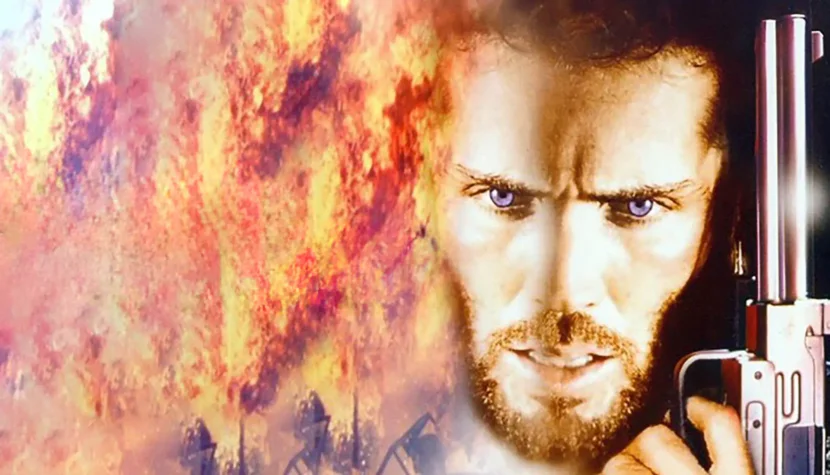STEEL FRONTIER: Where a Love for “Mad Max” and Clint Eastwood Leads in Science Fiction

The duo responsible for directing “Steel Frontier” likely won’t ring any bells for most people. Even back in the VHS days of the ’90s, this production might have only filled the lower shelves of neighborhood video rental stores. Joe Hart and Paul G. Volk created this film for a niche audience—die-hard fans of post-apocalyptic stories with sci-fi elements. They probably had a blast emulating “Mad Max”-style car chases. As for the story, which I’ll touch on shortly, it unfortunately doesn’t offer any fresh perspectives on a post-atomic world. But that’s not really the point; it’s less about providing a detailed backstory of the war or some concept like extracting fuel from car tires. The aim here is pure entertainment and creating a bold action hero, a role Joe Lara tries to take on. However, Brion James, with his recognizable name, overshadows him—not through his character but his presence. It’s a shame this unique actor didn’t have more commercial success.
Brion James didn’t exactly experience a meteoric rise after “Blade Runner“, though his image as a villain survived in cinema. Joe Lara, despite having played Tarzan, disappeared before his persona could really take off. The story of “Steel Frontier” is quite simple. On one of the most popular film databases, there isn’t even a proper summary for the movie; that’s how obscure “Steel Frontier” is as a title.
In this post-apocalyptic world, people have built a town called New Hope, where they aim to live, grow, forget the surrounding desert, and maybe even try to revive parts of the old civilization. No one remembers why the cataclysm happened. The creators don’t directly reference it, choosing instead a more metaphorical approach, which works well. Rather than dwelling on the world’s past problems, they focus on the present, attempting to engage viewers with the local community issues in New Hope. The town’s peace is disrupted, predictably, by a post-apocalyptic biker gang led by General Quantrell (Brion James), who leaves the town under the control of his bumbling son. Around this time, a mysterious loner and avenger—resembling a Jesus-like figure on a motorcycle—appears. He is the linchpin of the story. This character, Yuma (played by Joe Lara), joins the gang of Death Riders, but his mission is entirely different. He’s not there to pillage, ravage, or drink. The filmmakers envisioned him as the ultimate hero, an icon, a monument-worthy co-founder of a new civilization. But first, he must confront the remnants of the old world before moving forward. Yuma is on a path that he may or may not follow; he’s an outcast, a lone figure, almost a spirit. He comes and goes, pointing people in the right direction, but doing little else.

In this sense, Yuma resembles the Stranger from “High Plains Drifter”. Clint Eastwood portrayed that role so powerfully that it left an indelible mark on me. Joe Lara followed a similar path without turning the archetype into a gimmick, cliché, or amateur effort. He took the same route Eastwood did in 1973 and essentially carried the entire film. The western influences in “Steel Frontier” are unmistakable. The clashes between characters are not just typical shootouts but deliberate duels. The protagonist is an exceptionally skilled gunslinger, adding an extra layer of mystery. No one knows where he’s from or where he’s going, nor his motivations or goals. One thing is certain: in line with action cinema conventions, he protects the weak, even at the cost of his own life. Yuma represents the old rules and the old world, now gone. The problem is that the new world is uncertain, especially with gangs like the Death Riders aiming to dominate it. So, is there any hope? Probably not, unless ordinary people rally and take up arms. And that brings us to the second part of the film, which resembles “The Magnificent Seven” more than “High Plains Drifter”, albeit with less skilled fighters. The point here is to show that anyone can become a hero if given an example of courage and sacrifice.
“Steel Frontier” is a genre cocktail that’s difficult to classify. The plot is straightforward, with no mysteries, twists, or complex flashbacks. There’s even a romantic subplot, set against the backdrop of a ruined civilization. The music—true to the cheap cinema of the time—leans heavily on synthetic sounds and is ever-present. It’s interesting how films with smaller budgets relied heavily on background music, rarely allowing silence and continuously creating a mood, even when the scenes didn’t necessarily call for it. The sheer number of practical effects—explosions, demolitions, gunfire, and fights—is impressive. For a low-budget movie, the creators really made an effort to give the audience the sense that the film cost more than $10 million. I’ll admit, I don’t know the actual budget; I couldn’t find that information anywhere. And the ending? It just might surprise you…

